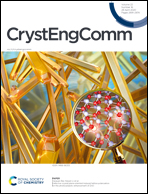Different effects in the selective detection of aniline and Fe3+ by lanthanide-based coordination polymers containing multiple reactive sites†
Abstract
In this paper, three isostructural 1D lanthanide complexes, [Ln(dppc)(H2O)4]n·2nH2O (Ln = Eu, Tb and Eu0.501Tb0.499, named 1-Eu, 2-Tb and Eu0.501Tb0.499), based on 3-(2,4-dicarboxylate phenyl)-2-pyridinecarboxylic acid (H3dppc) have been synthesized and characterized by elemental analysis, IR, PXRD, TG and X-ray crystallography. The complexes exhibit a 1D chain structure, which is further linked into a 3D supramolecular framework by hydrogen bonds. Tuneable emission colour of Eu0.501Tb0.499 is realized by adjusting the excitation wavelength. The sensing properties of 1-Eu and 2-Tb towards Fe3+ and aniline indicate that the two complexes have almost the same superior sensitivity and low detection limit for Fe3+ in aqueous solution, while they have different detection abilities for aniline in DMF solvent. The different detection abilities were discussed by means of PXRD, UV-vis, luminescence lifetimes and molecular surface calculations (Hirshfeld surface analysis and 2D fingerprint plots).



 Please wait while we load your content...
Please wait while we load your content...